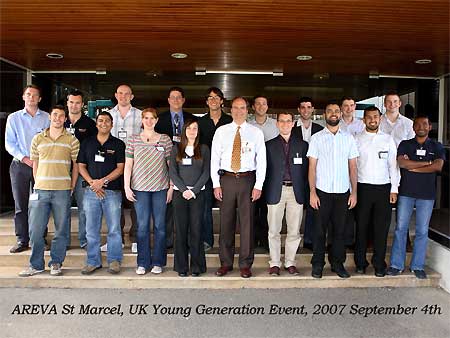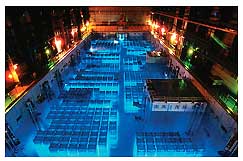
European
Nuclear Society
e-news
Issue 18 Autumn 2007
http://www.euronuclear.org/e-news/e-news-18/icem.htm

The BNES YGN was recently given the chance to present at the 11th International Conference on Environmental Remediation and Radioactiove Waste Management (ICEM 07), which was held, in Bruges, from 2-6 September. The YGN were invited to host 2 sessions, the first relating to workforce issues and training programmes and the second a panel session where we invited Jean Llewellyn, Project Director for the National Skills Academy for Nuclear, to join us and lead the debate about challenges facing the YGN. Both sessions were hosted by our YGN Chair Neil Crewdson and Vice Chair Linda McLean. The sessions were very positive, with all speakers leading a debate into the difficulties that we are facing and offering their perspectives on how we are responding to the change in demand for skills as we engage the current nuclear renaissance.
The first presentation was by George Reeves. He discussed the first 2 years in operation of DERC – a centre for decommissioning and environmental remediation in the highlands of Scotland and the problems he faces securing funding and places for future applicants. Sarah Greenwood from RM Consultants next explained how she has developed a programme to spot talent in graduates and support them through their career development until they become qualified and successful consultants. The Dalton Institute was represented by Warren Richards who discussed how industry, government and research councils are taking steps to reverse the 20 year trend of underinvestment that has led to the current skills shortage. He then focused on several programmes such as the development of the Dalton Institute and the national laboratory. Ogla Batyukhnova of Russia added an international dimension to the session by telling us about the last 10 years of the Moscow SIA Radon international education training centre and how they use several methods, including socio-psychological aspects, when assessing the efficiency of their training programmes aimed at ensuring that they can continuously improve training methods.
My presentation focused on graduates and how they are being developed in the UK. It focused on the highs and lows of graduate training and how the YGN and the NDA are focusing on improving graduate programmes to recruit and retain the best graduates into the industry.
The panel session kicked off with an introduction from Jean Llewellyn, which lead to a lively debate on the challenges the industry is facing due to the shortage of skills. The audience quickly joined in and Richard Mrowicki from the NDA answered some difficult questions relating to the NDA programme and how it was effecting the development and training programmes offered by some companies. Over all, the event was very forward-looking. The key messages that emerged from the conference were that we must work together to address the skills shortage and ensure that the nuclear industry is made more attractive for graduates and their career development.
For more information on the conference consult the ICEM 07 web site at: www.icemconf.com
Whilst the ICEM conference was going on a technical tour of France was also taking place. The tour was organised by Ben Salisbury of British Energy and the BNES YGN and hosted by AREVA and ENS.

The tour was attended by 17 BNES YGN members representing a variety of nuclear backgrounds. Starting in Marcoule, in the south of France, the tour travelled north to Flamanville, in Normandy, following the closed nuclear fuel cycle that Areva NC operates. This incorporated the reprocessing and recycling of plutonium and uranium for use in “MOX” fuel, as well as the segregation, treatment and disposal of used fuel elements and radioactive waste. The tour also included visits to the steel forge and metalworking plants which produce plant components. Finally an operating light water reactor was visited along with the building site of one of the world’s two new European pressurized reactors (EPRs).
The following is an extract from the full visit report, which can be found on the YGN website.
‘On Monday the tour started in Marcoule, Gard Region where we visited the Phénix, France’s second prototype Fast Neutron Reactor (FNR). The reactor is a research facility which can be configured to “breed” plutonium from fission in uranium 238, thereby increasing the amount of energy produced from natural uranium by 50%. Alternatively, the reactor can be used to “burn” radioactive waste and transmute long-lived fission products and actinides into stable elements or radioactive products with reduced half-lives. This process, if extended to a commercial scale, could reduce the nuclear waste legacy for future generations.
We also visited the Melox plant, which was on the same site, this plant takes plutonium and uranium oxide from Areva’s facilities at La Hague. These materials are mixed to the correct enrichment level for a particular fuel assembly.
The theme for Tuesday’s visit was the construction of the major steel assemblies used in nuclear power plants. The first location we visited was the Creusot forge plant belonging to the Sfar Steel Group. This forge is capable of producing very large forged steel components, some of them weighing up to 360 tons. During the tour a 150 ton ingot of steel was lifted out of one of the gas furnaces glowing red, placed into the 7500 ton press and had a 10 ton section sliced off. This activity made quite an impression on everyone. |
 |
Located deep in rural south-eastern France is the Andra waste disposal repository, final destination for 90% of Frances radioactive waste, was the destination on Wednesday. This site was especially chosen on account of the geological make-up of the environment. The intermediate and low-level waste (ILW & LLW) that is handled and stored at the facility is not just put into drums; complete pressure vessel heads are put in place. The group also visited a second site which handles very low-level waste (VLLW) and learned about the differences between British and French disposal methods.
|
 |
around 6,000 people it extends underground and all of the processing is remotely controlled to limit employee exposure.
The final stop on the tour was Flamanville, with its two EDF PWR reactors with a capacity of 1300MW each. These stations, although impressive, were not as interesting as the construction site next to them. In this site the foundations of the new Flamanville 3 EPR station have been laid. However, at this early stage all that could be seen were some basement sections and the bottom of the containment area. The site physically looks larger than the sister stations. This is intentional in order to provide 4 levels of system redundancy, increased lay down areas that enable easier maintenance and an increased power output of 1600MW. From the outset the EPR design is MOX adapted and builds upon the operating and construction experience obtained from the 93 other PWRs that Areva has built.
Standing there and looking at the framework of the new EPR under construction you were struck by the realisation that the future was unfolding before you. A closed fuel cycle with minimised volumes and toxicities of radioactive waste coupled to effective reprocessing and recycling of uranium and plutonium to reduce demand on world resources. And all this supporting a technology that is proven, safe, reproducible, low carbon, cost effective and currently supplying 80% of Frances energy needs. It certainly looks like a good model to work from.
Steven Wootten (British Energy)
![]()
© European Nuclear Society, 2007